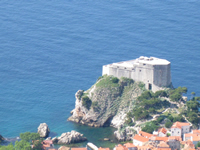 Built upon a 37 meter high sheer rock overlooking the sea, fortress Lovrijenac is one of the most impressive locations in Dubrovnik. This detached fortress was of prime importance for the defence of the western part of Dubrovnik, both against attack from land and the sea. During its service fortress was manned by 25 man garrison and a Commander of the fort. Built upon a 37 meter high sheer rock overlooking the sea, fortress Lovrijenac is one of the most impressive locations in Dubrovnik. This detached fortress was of prime importance for the defence of the western part of Dubrovnik, both against attack from land and the sea. During its service fortress was manned by 25 man garrison and a Commander of the fort.
 Chronologists date the fort to 1018 or 1038. However first records of the forts existence are from 1301 when the council voted on the Commander of the Fort. Chronologists date the fort to 1018 or 1038. However first records of the forts existence are from 1301 when the council voted on the Commander of the Fort.
According legend in the 11th century Venice planned to entrench its troops at this rock in front of Dubrovnik and build a fortress in order to conquer the City. However Dubrovnik learned of this plan and the citizens were mobilized to build a fortress at the very spot before arrival of the Venetians. They had been successful with the building project and as the Venetians came with ships carrying troops and supplies, much for their surprise, they realized their plan has failed.
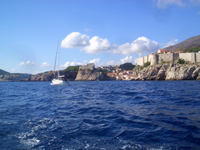 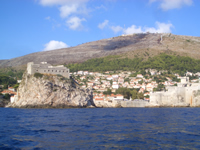
 The fortress was upgraded several times from its construction with major alterations made in the period of the 15th and 16th century at the time the municipal builder I. K. Zanchi of Pesaro was repairing the parapets. Having suffered damage in the earthquake of 1667, Lovrijenac was also repaired in the 17th century. The fortress was upgraded several times from its construction with major alterations made in the period of the 15th and 16th century at the time the municipal builder I. K. Zanchi of Pesaro was repairing the parapets. Having suffered damage in the earthquake of 1667, Lovrijenac was also repaired in the 17th century.
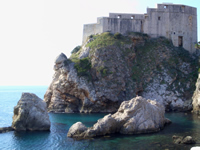 Triangular in plan and following the contour of the rock on which it was built, Lovrijenac faces the western suburbs with its narrowest, highest part, and its longest wall is open towards the tower Bokar and the western wall, thus protecting the small, but also the oldest port of the City - Kolorina. Triangular in plan and following the contour of the rock on which it was built, Lovrijenac faces the western suburbs with its narrowest, highest part, and its longest wall is open towards the tower Bokar and the western wall, thus protecting the small, but also the oldest port of the City - Kolorina.
The fortress has a quadrilateral court with mighty arches. As the height is uneven, it has 3 terraces with powerful parapets, the broadest looking south towards the sea.
Lovrijenac was defended with 10 large cannons, the largest being “Gušter” (the Lizard), marvelously carved and decorated. It never fired a single shot. It was designed and cast in 1537 by master founder Ivan Rabljanin. The Lizard is now lost at the bottom of the sea below Lovrijenac, as in the time when the Fortress was being disarmed by the Austrian troops in the 19th century, a rope holding the gun had broken off during hoisting and transport hence the gun fell to the depths. It was never recovered.
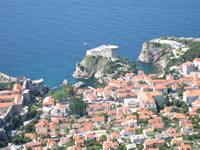 Being a dominant fortress whose capture could threaten defensive position of whole Dubrovnik a fail safe mechanism was designed into the fortress. The walls exposed to the sea and possible enemy fire are almost 12 meters thick (40 feet), but the large wall surface facing the City does not exceed 60 centimetres (2 feet). The caution of the Republic was not only directed against the foreign enemy, but also against possible rebellion of the Commander in charge of the fort garrison. In case of any trouble, the thin wall could never hold against the firepower of the mighty Bokar fortress facing Lovrijenac. In addition, the Commander of the fortress had always been elected from the rank of the nobility and replaced each month. Being a dominant fortress whose capture could threaten defensive position of whole Dubrovnik a fail safe mechanism was designed into the fortress. The walls exposed to the sea and possible enemy fire are almost 12 meters thick (40 feet), but the large wall surface facing the City does not exceed 60 centimetres (2 feet). The caution of the Republic was not only directed against the foreign enemy, but also against possible rebellion of the Commander in charge of the fort garrison. In case of any trouble, the thin wall could never hold against the firepower of the mighty Bokar fortress facing Lovrijenac. In addition, the Commander of the fortress had always been elected from the rank of the nobility and replaced each month.
Over the entrance to Lovrijenac fortress an ancient inscription reads as follows: NON BENE PRO TOTO LIBERTAS VENDITUR AURO. In translation: Freedom is not sold for all the gold in the world.
 In search for space suitable for theatre productions during the Dubrovnik Summer Festival, it was observed very early that 3 terraces of Lovrijenac fortress have great potential. Lovrijenac is especially suitable as the stage for Shakespeare's “Hamlet”, an its production with the ambiance stage of Lovrijenac fortress is unforgettable. In search for space suitable for theatre productions during the Dubrovnik Summer Festival, it was observed very early that 3 terraces of Lovrijenac fortress have great potential. Lovrijenac is especially suitable as the stage for Shakespeare's “Hamlet”, an its production with the ambiance stage of Lovrijenac fortress is unforgettable.
|